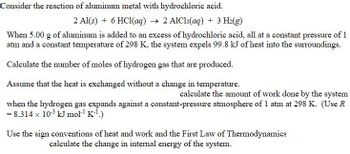
Introduction to Chemical Engineering Thermodynamics
8th Edition
ISBN: 9781259696527
Author: J.M. Smith Termodinamica en ingenieria quimica, Hendrick C Van Ness, Michael Abbott, Mark Swihart
Publisher: McGraw-Hill Education
expand_more
expand_more
format_list_bulleted
Question

Transcribed Image Text:Consider the reaction of aluminum metal with hydrochloric acid.
2 Al(s) + 6 HCl(aq) → 2 AlCl3(aq) + 3 H₂(g)
When 5.00 g of aluminum is added to an excess of hydrochloric acid, all at a constant pressure of 1
atm and a constant temperature of 298 K, the system expels 99.8 kJ of heat into the surroundings.
O Calculate the number of moles of hydrogen gas that are produced.
Assume that the heat is exchanged without a change in temperature.
calculate the amount of work done by the system
when the hydrogen gas expands against a constant-pressure atmosphere of 1 atm at 298 K. (Use R
= 8.314 x 10³ kJ mol-¹ K-¹.)
Use the sign conventions of heat and work and the First Law of Thermodynamics
calculate the change in internal energy of the system.
Expert Solution
This question has been solved!
Explore an expertly crafted, step-by-step solution for a thorough understanding of key concepts.
This is a popular solution
Trending nowThis is a popular solution!
Step by stepSolved in 5 steps with 7 images

Knowledge Booster
Similar questions
- (2) Calculate the heat of reaction at 298K for the following reactions a) 3NO2(g) + H₂O(0) b) C3Hs (g) +02 (8) c) CaCO3(s) 2HNO3(+NO(g) ►CO2(g) + H₂O(n CaO(s)+COz(g)arrow_forwardThe equilibrium constant with respect to temperature can be expressed for the reaction: Cyclohexane (g)! <--> methylcyclopentane (g) as: LnK = 4.814-2059/T. If placed to react 3 moles cyclohexane in a 5 liter container at a certain temperature and when equilibrium is reached, 8000 J of heat is released, Calculate the temperature of the container.arrow_forward***** Calculate the amount of heat required to convert 20.0 g of ice (HC = 0.5 cal/g/oC) at -10.0 oC to steam (HC = 0.5 cal/g/oC) at 120 oC given that the fusion of water needs 80.0 cal/g and its vaporization needs 540 cal/g.arrow_forward
- The reaction of carbon monoxide(g) with water(l) to form carbon dioxide(g) and hydrogen(g) proceeds as follows: CO(g) + H2O(l) ---> CO2(g) + H2(g) When 10.2 grams of CO(g) react with sufficient H2O(l) , 1.02 kJ of energy are absorbed .What is the value of H for the chemical equation given?arrow_forward(d) Determine the weight percentage, wt%, of the solid solution and liquid solution of a Cu-Ni alloy with a composition of 21 % Ni 79 % Cu, at a temperature of 1050 °C. Use part of the Thermal Equilibrium Diagram for Copper (Cu)-Nickel (Ni) alloy, as shown in Figure 1. Clearly show all your calculations. Temperature "C Figure 1 Part of the Cu-Ni thermal equilibrium diagram (not to scale) 1050 11 21 29 % Niarrow_forwardThe fuel in the form of biogas (65%-mol CH4 and 35%-mol CO2) is burned in a furnace. In order for combustion to take place stoichiometrically, calculate the air to fuel ratio (vol/vol) from this problem!arrow_forward
- Question: Consider the sugar–water phase diagram of Figure 10.1. (a) How much sugar will dissolve in 1000 g of water at 80°C (176°F)? (b) If the saturated liquid solution in part (a) is cooled to 20°C (68°F), some of the sugar will precipitate out as a solid. What will be the composition of the saturated liquid solution (in wt% sugar) at 20°C? (c) How much of the solid sugar will come out of the solution upon cooling to 20°C? Figure 10.1 is provided below.arrow_forward4. At 1084 °C solid copper melts to form a liquid. The phase change can be described as Cu(s) → Cu(t). The density of solid and liquid copper are 8.96 g/cm' and 7.75 g/cm' respectively. The enthalpies of combustion of the solid and liquid are -156.06 kJ/mol and -167.92 kJ/mol respectively. The product of combustion of both the solid and liquid is CuO(s). Calculate the standard enthalpy changes for the fusion process in kJ/mol. Calculate the change in internal energy when the sample is under a pressure of 500 kbar. Cu(s) → Cu(e) Solid copper liquid copper enthalples of combustion 8.96 g/cm3 7.75 g 1cm² said: -156.06 kJ/mol liquid-162.42 kJ/molarrow_forward
arrow_back_ios
arrow_forward_ios
Recommended textbooks for you
 Introduction to Chemical Engineering Thermodynami...Chemical EngineeringISBN:9781259696527Author:J.M. Smith Termodinamica en ingenieria quimica, Hendrick C Van Ness, Michael Abbott, Mark SwihartPublisher:McGraw-Hill Education
Introduction to Chemical Engineering Thermodynami...Chemical EngineeringISBN:9781259696527Author:J.M. Smith Termodinamica en ingenieria quimica, Hendrick C Van Ness, Michael Abbott, Mark SwihartPublisher:McGraw-Hill Education Elementary Principles of Chemical Processes, Bind...Chemical EngineeringISBN:9781118431221Author:Richard M. Felder, Ronald W. Rousseau, Lisa G. BullardPublisher:WILEY
Elementary Principles of Chemical Processes, Bind...Chemical EngineeringISBN:9781118431221Author:Richard M. Felder, Ronald W. Rousseau, Lisa G. BullardPublisher:WILEY Elements of Chemical Reaction Engineering (5th Ed...Chemical EngineeringISBN:9780133887518Author:H. Scott FoglerPublisher:Prentice Hall
Elements of Chemical Reaction Engineering (5th Ed...Chemical EngineeringISBN:9780133887518Author:H. Scott FoglerPublisher:Prentice Hall
 Industrial Plastics: Theory and ApplicationsChemical EngineeringISBN:9781285061238Author:Lokensgard, ErikPublisher:Delmar Cengage Learning
Industrial Plastics: Theory and ApplicationsChemical EngineeringISBN:9781285061238Author:Lokensgard, ErikPublisher:Delmar Cengage Learning Unit Operations of Chemical EngineeringChemical EngineeringISBN:9780072848236Author:Warren McCabe, Julian C. Smith, Peter HarriottPublisher:McGraw-Hill Companies, The
Unit Operations of Chemical EngineeringChemical EngineeringISBN:9780072848236Author:Warren McCabe, Julian C. Smith, Peter HarriottPublisher:McGraw-Hill Companies, The

Introduction to Chemical Engineering Thermodynami...
Chemical Engineering
ISBN:9781259696527
Author:J.M. Smith Termodinamica en ingenieria quimica, Hendrick C Van Ness, Michael Abbott, Mark Swihart
Publisher:McGraw-Hill Education

Elementary Principles of Chemical Processes, Bind...
Chemical Engineering
ISBN:9781118431221
Author:Richard M. Felder, Ronald W. Rousseau, Lisa G. Bullard
Publisher:WILEY

Elements of Chemical Reaction Engineering (5th Ed...
Chemical Engineering
ISBN:9780133887518
Author:H. Scott Fogler
Publisher:Prentice Hall


Industrial Plastics: Theory and Applications
Chemical Engineering
ISBN:9781285061238
Author:Lokensgard, Erik
Publisher:Delmar Cengage Learning

Unit Operations of Chemical Engineering
Chemical Engineering
ISBN:9780072848236
Author:Warren McCabe, Julian C. Smith, Peter Harriott
Publisher:McGraw-Hill Companies, The